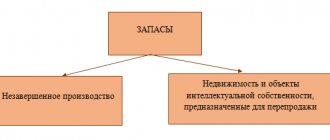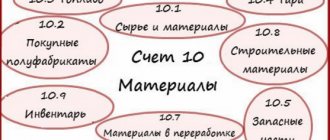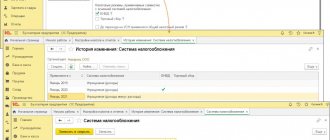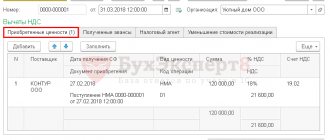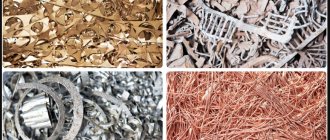What applies to MPZ
Inventory in the accounting of Russian organizations are those assets that, according to clause 2 of the PBU:
- They are used in the manufacture of goods and materials/performing services as material resources, semi-finished products, and raw materials.
- Intended for resale.
- They are written off as administrative expenses of the company (household equipment, workwear, stationery, etc.).
Depending on the purpose, main and auxiliary supplies, semi-finished products, containers, spare parts, and returnable materials are distinguished. Inventory accounting reflects data on goods and GP (finished products), but excludes information on work in progress (clause 4 of PBU). The main typical accounting entries for inventories are given below.
Concept, classification and tasks of inventory accounting
In accordance with the Accounting Regulations “Accounting for Inventories” (PBU 5/01 dated 06/09/01), the following assets are accepted for accounting as inventories (MPI):
- used as raw materials in the production of products intended for sale, performance of work, provision of services;
- used for the management needs of the organization;
- intended for sale.
The inventories include the following groups of current assets:
- materials - part of the materials and materials, which are objects of labor, provide, together with the means of labor and labor, the production process of the organization in which they are used once. They are entirely consumed in the production cycle and fully transfer their value to the cost of the products produced (work performed, services provided);
- inventory and household supplies - part of the inventories used as means of labor for no more than 12 months or the normal operating cycle, if it does not exceed 12 months;
- finished products - part of the inventories intended for sale and being the end result of the production process;
- goods - part of goods purchased from legal entities for the purpose of their sale or resale without additional processing.
The main tasks of inventory accounting:
- correct and timely documentation of all operations on the movement of material assets;
- control over the receipt and procurement of material assets;
- control over the safety of material assets in places of their storage and at all stages of processing;
- systematic control over the identification of excess and unused materials and their sale;
- timely settlements with suppliers of inventories.
Inventory in accounting - current amendments
The Ministry of Finance, in Order No. 64 dated May 16, 2016, introduced changes to the simplified accounting of inventories, or rather to the methods of asset valuation:
- The supplier's price can be used for purchased inventories - according to clause 13.1, other costs for the purchase of inventories are allowed to be written off in full as normal expenses.
- The purchase price of inventories for the production of goods and materials is used by micro-enterprises, as well as in the presence of insignificant balances of inventories - according to clause 13.2, other costs for the production/preparation of goods for sale are also allowed to be included in ordinary expenses.
- The purchase price of inventories spent for management needs is charged to costs in their entirety as they are acquired (clause 13.3 of the PBU).
Note! Let us recall that previously, inventories in accounting using a simplified method were taken into account by organizations at the actual cost, which depends on the option for purchasing inventories.
The innovations do not affect the methods of writing off inventories for production. PBU contains the following options for assessing inventories upon disposal (clause 16):
- Average cost.
- Cost of each unit.
- FIFO.
Documents that accompany the accounting of receipt of inventories
Inventory accounting is associated with the preparation of documents, which can be divided into two groups: external and internal.
External documents are those issued by suppliers of goods and materials: waybill and invoice, waybill. Internal documents document material assets moved within the organization.
The receipt of material assets at the warehouse is accompanied by a receipt order in form No. M-4, an act of acceptance of materials in form No. M-7 (for uninvoiced deliveries). The release of materials into production and for other needs is accompanied by the issuance of a limit and intake card in form No. M-8.
The transfer of materials between structural units of the enterprise or responsible persons may be accompanied by a requirement-invoice for the release of materials in form No. M-11. This form is also used to return unused material to the warehouse.
If the structural units of the enterprise are located remotely from each other, an invoice in form No. M-15 is used to transfer materials between them. It is also used to transfer material assets to third-party companies, for example, when transferring raw materials.
Since January 2013, the organization has the right to use its own forms of primary documents (Law “On Accounting” dated December 6, 2011 No. 402-FZ), securing them in its accounting policies.
Accounting entries for inventories
In order to organize a reliable reflection of the acquisition and write-off of inventories for production and other needs, the enterprise accountant must maintain synthetic and analytical accounting of inventories by name, storage location, etc. According to the Chart of Accounts, the following main accounts are used - 10, 43, 41, 11, 15 , 16; off-balance sheet – 002, 003, 004.
Supporting primary documents are limit cards, invoices, acceptance certificates, requirements, warehouse cards, advance reports, accounting statements, etc. For enterprises that do not use simplified accounting, the acceptance of inventories for accounting is carried out at actual cost (clause 5 of PBU ), determined depending on the source of acquisition. The selected method for valuing inventories upon disposal should be fixed for the reporting period in the company's accounting policy.
Guidelines for accounting for inventories
Methodology for accounting of inventories was adopted by order of the Ministry of Finance of the Russian Federation dated December 28, 2001 No. 119n. They regulate the accounting of inventories of organizations, except for credit and budgetary ones. Let's consider the main provisions.
MPZ cost
Determining the value of inventories depends on the method of their receipt: material assets can be purchased for a fee or free of charge, produced by the organization itself, or contributed as authorized capital.
The cost of purchased material assets is equal to actual expenses minus VAT and other refundable taxes.
The actual expenses also add up to the cost of material assets produced by the organization itself.
The cost of inventories received free of charge is equal to their market value at the time of receipt by the organization.
Valuables that are not the property of the company are recorded at a price agreed with the owners on the accounts off the balance sheet.
Assets purchased in That is, they are taken into account at a price calculated in rubles at the exchange rate of the Central Bank of the Russian Federation on the date of acceptance for accounting.
Reserve for reduction in the value of material assets
The guidelines provide for the formation of a reserve in the event of a decrease in value or moral and physical wear and tear of the inventory. It is accrued to the “Other income and expenses” account.
You can find out under what conditions a reserve is formed in the material “Accounting for reserves for a decrease in the value of material assets.”
Disposal of oil and gas plant
Disposal of inventories can occur in one of three ways:
- at the cost of each unit;
- at average cost;
- at the cost of the first supplies purchased (FIFO method).
The chosen method is fixed in the accounting policy and is applied from month to month.
Main features of inventory accounting
The following features are inherent in accounting for inventories:
- numerical accounting of the movement of various types of inventories is carried out in warehouses using warehouse registration cards;
- cash accounting is carried out using synthetic accounts, sub-accounts and storage locations;
- at the end of the month, the warehouse accounting information in monetary value is compared with the numerical indicators of inventory balances in warehouses.
To control the accounting and safety of inventories, an inventory is provided.
You will find the regulations governing its implementation in the article “Inventory of inventories”.
Synthetic accounting of materials
Synthetic accounting of the availability and movement of material resources is kept on account 10 “Materials”. Active account, balance account, inventory account.
The balances of material assets and their receipt are recorded on the debit of account 10, expenses and releases are recorded on the credit of account 10 at actual cost. The debit of account 10 includes all costs of their acquisition (purchase cost of materials, transport services, customs duties, etc.) from the credit of accounts for accounting for settlements.
The receipt of materials into an organization can occur for various reasons and is reflected in accounting by the following entries:
- purchased from suppliers: Dt 10 Kt 60 - for the purchase price, Dt 19 Kt 60 - for the amount of VAT;
- from the founders as a contribution to the authorized capital: D-t 10 K-t 75/1 - at the agreed price;
- free of charge from other organizations: D-t 10 K-t 98/2, sub-account “Free receipt” - at the current market value on the date of acceptance for accounting
When using gratuitously received materials for production needs (D-t 20, 23, 25, 26 K-t 10), at the same time the cost of consumed materials is included in other income and is reflected in accounting by posting: D-t 98/2 K-t 91;
- scrap waste: D-t 10 K-28;
- waste from the liquidation of fixed assets (at current market value): D-t 10 K-t 91.
The release of materials from the warehouse is carried out for various purposes and is reflected in the following transactions:
- for the manufacture of products: D-t 20, 23 K-t 10;
- for the construction of fixed assets: D-t 08 K-t 10;
- for repair of fixed assets: D-t 25, 26 K-t 10;
- external sales
Accounting for the sale of materials is kept on account 91 “Other income and expenses.” The account is active-passive, has no balance, and in terms of economic content is operational and effective.
The debit of account 91 reflects:
- actual cost of materials sold: D-t 91 K-t 10;
- amount of VAT accrued on materials sold: D-t 91 K-t 68;
- expenses for the sale of materials: D-t 91 K-t 70, 69, 76. The loan reflects:
- proceeds from sales at selling prices, including VAT: D-t 62 K-t 91.
By comparing the turnover on account 91, the financial result from the sale is determined.
If the debit turnover is greater than the credit turnover (debit balance), we get a loss. It is written off to account 99 “Profit and Loss” by posting: D-t 99 K-t 91.
If the debit turnover is less than the credit turnover (credit balance), it is written off by posting: Dt 91 Kt 99.
The chart of accounts provides for account 10 “Materials” and subaccounts.
Organizations engaged in the production of agricultural products can open separate sub-accounts for account 10 to account for seeds, feed, pesticides, and mineral fertilizers.
When registering special equipment and special clothing received at the warehouse, the following entries are made in accounting: D-t 10/10 K-t 60 - for the purchase price, D-t 19 K-t 60 - for the amount of “input” VAT.
The transfer of the specified material assets into operation is formalized by posting: D-t 10/11 K-t 10/10.
The actual cost of materials consumed is recorded in order journals 10, 10/1 in correspondence: D-t 20, 23, 25, 26, 08, 91 K-t 10.
Inventory valuation
To properly organize the accounting of inventories in organizations, a nomenclature-price tag is developed. Nomenclature is a systematic list of names of materials, spare parts, fuel and others used in a given organization. Each name of materials is assigned a numerical designation - a nomenclature number.
The nomenclature-price tag indicates the accounting price and unit of measurement of materials.
According to PBU 5/01, inventories are accepted for accounting at actual cost, which includes the amount of actual costs associated with their acquisition and delivery.
The actual costs of purchasing inventories (MPI) include:
- amounts paid in accordance with the agreement to the supplier (seller);
- amounts paid to organizations for information and consulting services related to the acquisition of inventories;
- customs duties;
- non-refundable taxes paid in connection with the acquisition of inventory;
- fees paid to the intermediary organization through which the inventories were acquired;
- costs of procuring and delivering materials to the place of their use, including insurance costs;
- costs of maintaining the procurement and warehouse division of the organization, costs of transport services for the delivery of materials and materials to the place of their use, if they are not included in the price of goods and materials established by the contract;
- costs of bringing materials and equipment to a state in which they are suitable for use for the intended purposes;
- other costs directly related to the acquisition of inventories.
The actual cost of inventories during their production by the organization itself is determined based on the actual costs associated with the production of these inventories.
The actual cost of inventories contributed by the founders as a contribution to the authorized (share) capital is determined based on their monetary value, agreed upon by the founders (participants) of the organization.
The actual cost of inventories received by an organization under a gift agreement or free of charge is determined based on their current market value as of the date of acceptance for accounting.
The actual cost of materials can be calculated only at the end of the month, when the accounting department will have the components of this cost (payment documents from suppliers of materials, for transportation, loading and unloading and other expenses).
The movement of materials occurs in the organization on a daily basis, and documents for receipts and expenditures must be completed in a timely manner. Most organizations keep current records using fixed accounting prices. These could be average purchase prices.
If purchase (contractual) prices are used in current accounting, at the end of the month the amounts and percentage of transportation and procurement costs are calculated to bring them to the actual cost.
When choosing an accounting policy for the coming year, an organization may provide for one of the following methods for valuing materials written off for production:
- at average (weighted average) cost;
- at the cost of the first purchases (FIFO method).
The average cost is determined for each type (group) of inventory as the quotient of dividing the total cost of the type (group) of inventory by their quantity, respectively, consisting of the cost and quantity for the balance at the beginning of the month and for incoming inventory in the reporting month.
This method of assessing material resources is traditional for domestic accounting.
With the FIFO method, inventories are written off to production sequentially in the order of their delivery to the enterprise according to the principle: “first batch in, first out.” This means that, regardless of which batch is released into production, materials are first written off at the price of the first purchased batch, then the second, etc.
The advantage of the method is that it allows you to obtain the remaining amount of material assets at the prices of the most recent purchases, which most closely coincide with the current market value.
In tax accounting, the cost of inventories is formed in the same way as in accounting, from the actual costs of the organization for their acquisition.
Example.
Valuation of materials using the FIFO method
| Indicators | Number of units, kg | Price per unit, rub. | Amount, rub. |
| 1. Remaining materials at the beginning of the month | 30 | 15 | 450 |
| 2. Materials received within a month: | |||
| first batch | 40 | 18 | 720 |
| second batch | 20 | 20 | 400 |
| third party | 80 | 25 | 2000 |
| Total income for the month | 140 | — | 3120 |
| 3. Material consumption per month (150 kg) | |||
| Write-off using the FIFO method | 30 | 15 | 450 |
| 40 | 18 | 720 | |
| 20 | 20 | 400 | |
| 60 | 25 | 1500 | |
| Total consumption for the month | 150 | — | 3070 |
| 4. Balance of materials at the end of the month using the FIFO method | 20 | 25 | 500 |
Calculation of the weighted average cost per unit of material (initial data from the table)
1. We determine the cost of a given type of material in circulation at the enterprise:
450 + 3120 = 3570 (rub.).
2. Determine the amount of material:
30 + 140 = 170 (kg).
3. Determine the average actual cost per unit of material:
3570 : 170 = 21 (rub.)
4. The actual cost of the material consumed is:
21 rub. X 150 kg = 3150 rub. The balance at the end of the month will be:
20 kg at a price of 21 rubles. for the amount of 420 rubles.
The FIFO method understates the cost of goods manufactured and accordingly increases taxable income. The cost of the remaining materials in the warehouse is the highest. The average cost method allows you to achieve a golden mean. After all, it takes into account price fluctuations and smooths them out.
